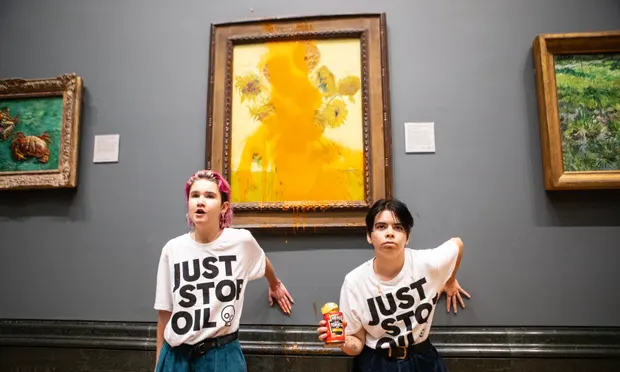The Ethics of Destroying Art in Protest
Recently, climate activists and groups, prominently across Europe, have been finding and executing new ways to protest the declining state of our environment in hopes to reach the public’s undivided attention. Part of this mission has been vandalizing priceless and greatly sentimental artworks in world-renowned museums like London’s National Gallery of Art and the Leopold Museum in Vienna.
On Monday, November 15th, 2022, two environmental protestors threw “black, oily liquid” on Gustav Klimt’s Death and Life in Vienna, which was fortunately shielded by protective glass. Desiring to protest “oil and gas drilling … a death sentence to society”; the two protestors did not intend to ruin the painting, but instead spread a powerful message that they saw was not being taken as seriously as it should be. The liquid, a symbolic memento of “ruining” art previously seen as perfect, is causing uproar among thousands, and deeply intriguing others. There is an evident meaning behind these protests as well as deep-rooted symbolism, but it has come at the price of passionate criticism and anger among the majority of the public.
The motives are these activists are clear and have been directly articulated by members of the group themselves. In hopes to strengthen their impact, they aim to spread awareness of global climate change through a vessel that catches the attention of the public at a greater level. These protests have influenced those who have emotional connections with the valuable, beautiful, and carefully preserved evidence of human talent, beauty, and intelligence as well as the lovers and critics of iconic artworks such as Edvard Munch’s The Scream. These actions are grasping the world’s attention, but what will be done? Are these protests being taken seriously or disregarded? The fine line between offensive, uncalled-for action and eye-opening, emblematic action has recently become an issue and a divide among those passionate about art, the state of our planet, and activism.
Now for my Opinion…
I must admit, initially I thought that the actions of these protestors were brutal and offensive, disrespecting artistic expression that was carefully preserved for hundreds of years. But as I deep dived further into the motives of the protestors, it is clear that the vast majority of them wish for their actions to be a way to get and keep the attention of the public without violence. The abusive use of fossil fuels and the state of our declining environment is a terrifyingly serious issue, one that must be addressed in a more abrupt manner- and this is exactly what the activists a part of the U.K’s Just Stop Oil, Germany’s Letzte Generation, and Italy’s Ultima Generazione believe. However, I feel that if these protests continue, it is imperative that they guarantee the original artwork to not be damaged, and in doing so, provide a bridge between activism and art, rather than a strong blockade.
From gluing themselves to Johannes Vermeer’s iconic Girl With a Pearl Earring to hurling tomato soup at Van Gogh’s Sunflowers, the activists are representing the profoundly ignored issue of our declining earth among a sea of realism artworks; like an elephant in the room that needs to be abruptly and seriously addressed. The activists’ actions are no doubt impactful and meaningful- the message they are sending put environmental health in perspective; forcing people to think about the fact that if we continue to destroy our earth, once in it’s perfect state, our posterity will not have the privilege to live and experience an unpolluted and healthy planet. Although the activists’ actions can be viewed as childish, illogical, and disrespectful, the reality is that activists have been forced to go to these lengths in order to be merely acknowledged, even if that means risking 10-15 years in prison.
Connecting activists and artists is perhaps one of the most striking tactics because of the emotions that it evokes around the world. Art is something that connects all of us, and the symbolism of protesting our planet through targeting artwork is ineffable. All over the world, activists ranging from 18 to 75 years old are taking it upon themselves to initiate change for the greater good, and I believe that that in itself is a beautiful thing.

Anika Hundley is 17 years old and a Junior at East High. She was born in Pittsburgh, Pennsylvania and is very determined to return to the east (preferably...










